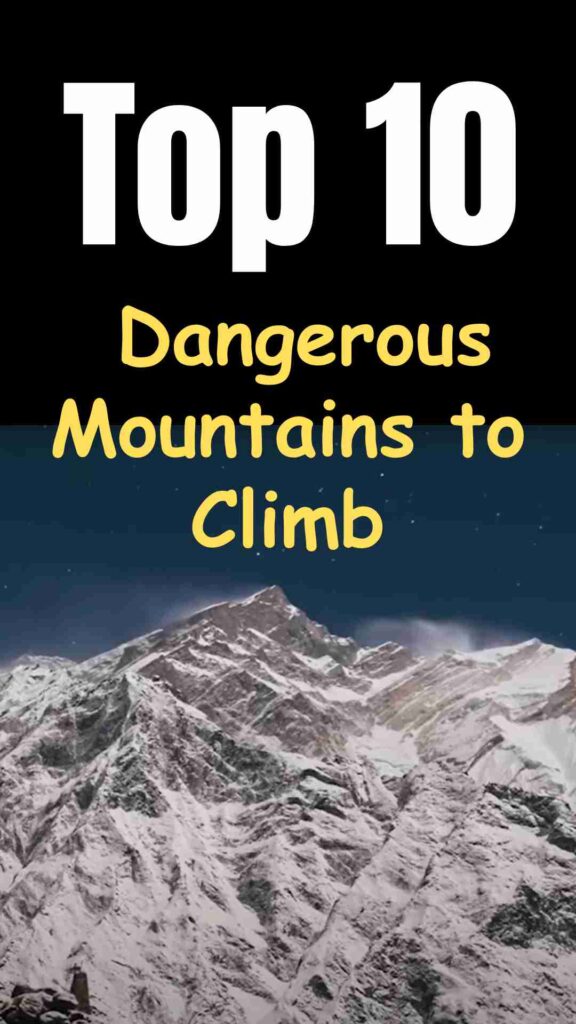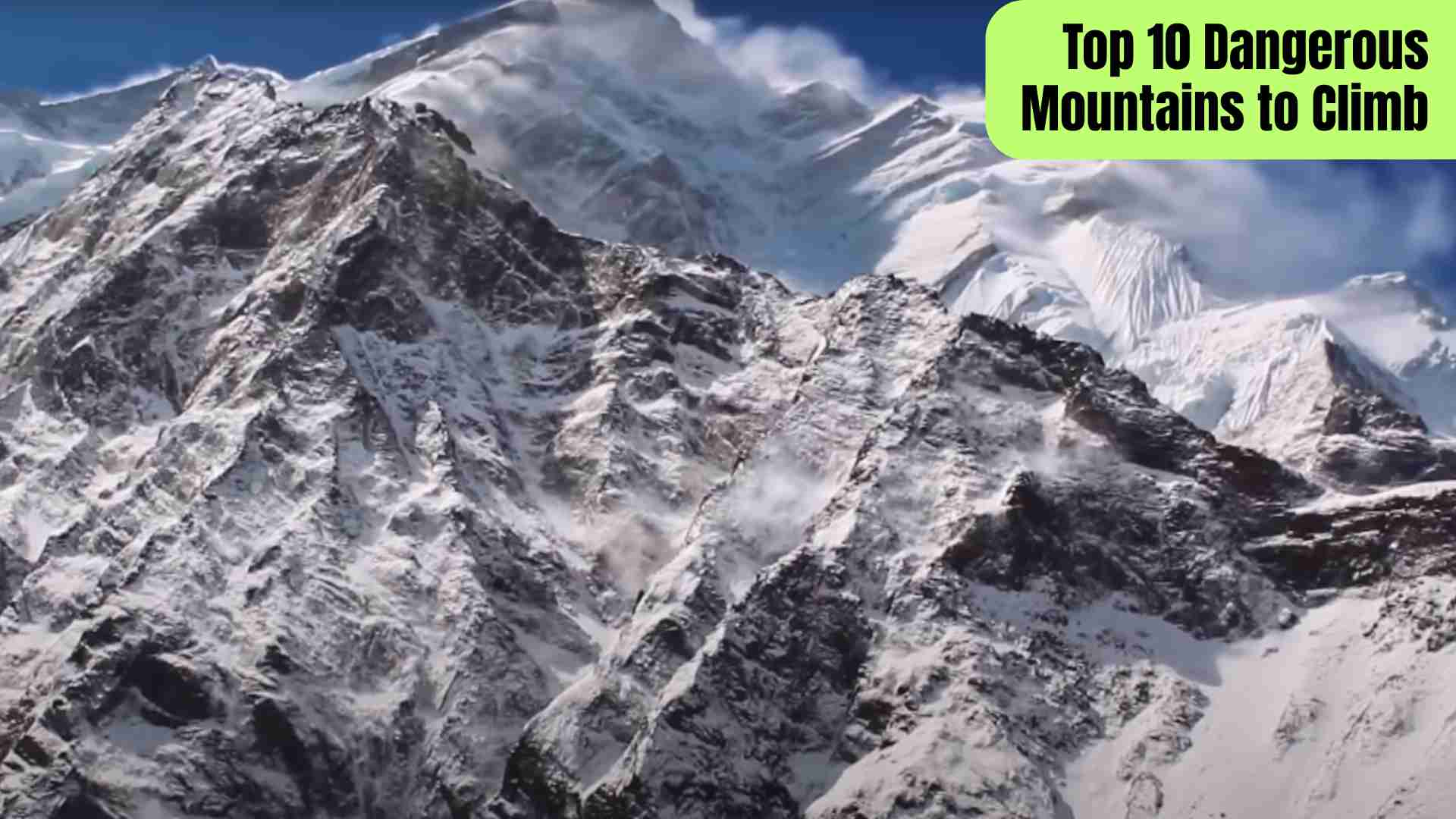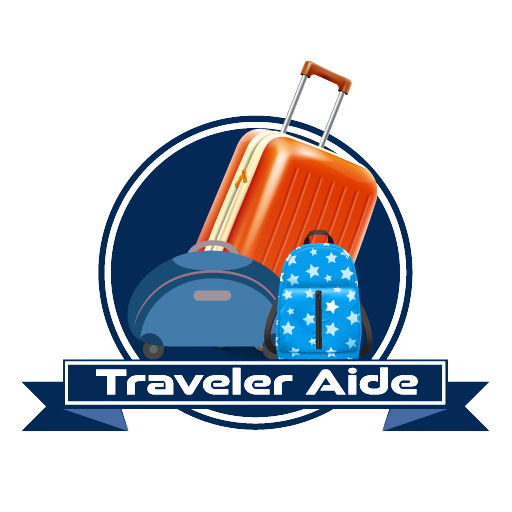You ever stand at the base of a mountain and feel a mix of awe… and fear? That feeling—like the mountain is watching you back—isn’t just in your head. Some peaks aren’t just hard to climb—they’re downright deadly. These are the mountains where nature doesn’t play fair, and one mistake can cost you everything.
This list of the Top 10 Dangerous Mountains to Climb isn’t meant to scare you off (okay, maybe just a little). It’s here to show you what it really takes to go where most people never dare. These aren’t your average hiking trails. These are places where avalanches roar, storms hit like a wall, and altitude messes with your mind.
Ready? Let’s start with a mountain that doesn’t just challenge climbers—it buries them.
1. Annapurna I, Nepal
Fatality Rate: Around 27%
Annapurna I is stunning from a distance—but up close, it’s a different story. Towering at 8,091 meters (26,545 feet), it’s one of the deadliest mountains on Earth. Nearly one in four climbers who try to reach the summit don’t make it back.

Why is it so dangerous? For starters, its south face is like a death trap—steep, icy, and avalanche-prone. The weather changes without warning. You could be basking in sunshine, then buried under snow 30 minutes later.
And here’s the scariest part: even the best in the world haven’t been spared. Climbers like Ueli Steck—who could run up mountains faster than most of us can jog—lost their lives here. Annapurna doesn’t care how experienced you are. It demands respect, and even then, it doesn’t promise anything.
2. K2, Pakistan
Known as: “The Savage Mountain”
Elevation: 8,611 meters (28,251 feet)
K2 doesn’t just test your climbing skills—it tests your sanity. Second only to Everest in height, it’s widely considered the most dangerous mountain in the world. Why? Because everything about it is unforgiving.
First, there’s no easy route. Every path to the summit is a gamble. Then there’s the Bottleneck—a terrifying section where you have to climb beneath massive hanging ice towers that could collapse any second.
Add in unpredictable storms, extreme cold, and the fact that rescue missions are nearly impossible, and you start to get the picture. People don’t just die here. They vanish. K2 is where even seasoned climbers hesitate. It’s not called “The Savage Mountain” for nothing.
3. Nanga Parbat, Pakistan
Nickname: “Killer Mountain”
Fatality Rate: ~20% (historically)
The name says it all—Killer Mountain. Standing at 8,126 meters (26,660 feet), Nanga Parbat is as menacing as it sounds. It’s massive, lonely, and brutally difficult to climb. Especially from the Rupal Face, which is the tallest mountain face on the planet.
Before it was first climbed in 1953, 31 people had already died trying. And even today, it’s far from safe. Icefalls, avalanches, and sheer exposure make it one of the riskiest ascents you can attempt.
What makes it worse is its psychological toll. The mountain feels isolating. The kind of place where you can hear your own heartbeat—and not in a good way. One climber said, “Nanga Parbat doesn’t just want to kill you—it wants to watch you suffer first.”
4. Kangchenjunga, Nepal-India Border
Third Highest Mountain: 8,586 meters (28,169 feet)
Fatality Rate: About 22%
Kangchenjunga isn’t as talked about as Everest, but it’s far more dangerous. It’s wild, remote, and brutally cold. At 8,586 meters, it’s the third highest mountain in the world, and easily one of the most challenging.
What makes it so lethal? Everything. Long, risky approaches. Fast-changing weather. And a final push to the summit that tests every ounce of your strength and nerve.
There’s also a spiritual angle. Locals consider the summit sacred, so climbers usually stop just short of the top. But even getting that close is no joke. One wrong move on its narrow ridges, and you’re gone. Kangchenjunga demands patience, humility, and a whole lot of luck.
5. Dhaulagiri I, Nepal
Height: 8,167 meters (26,795 feet)
Fatality Rate: ~16%
Dhaulagiri isn’t as famous as some of its Himalayan neighbors, but maybe that’s part of its danger. People underestimate it—and that’s a mistake.
Its name means “White Mountain,” and it looks peaceful from a distance. But once you’re on it, it’s anything but gentle. It’s icy, steep, and scattered with avalanche-prone slopes. Climbers often describe it as “isolated”—you feel like the last person on Earth up there.
Rescue isn’t easy here either. If something goes wrong—and it often does—you’re on your own. It’s cold, unforgiving, and doesn’t give second chances.
6. Makalu, Nepal
Height: 8,485 meters (27,838 feet)
Fatality Rate: Around 9%
Makalu doesn’t scream danger at first glance. But trust me—it’s quietly brutal. Towering just east of Everest, it’s the fifth highest mountain in the world, and yet, it gets far less attention. Maybe that’s because the people who climb it rarely come back bragging—they’re just happy to come back at all.
The mountain is known for its sharp ridges and knife-like summit pyramid. The climb involves long stretches of technical rock and ice climbing, especially near the top. No easy walk here.
And the weather? Unforgiving. Strong winds are constant above 7,000 meters, and storms roll in with little warning. On Makalu, it often feels like the mountain is trying to shake you off. One misstep, and you’re on an endless fall through silence.
7. Manaslu, Nepal
Height: 8,163 meters (26,781 feet)
Fatality Rate: Historically around 9%
Manaslu might sound a bit more familiar—especially to climbers looking for their first 8,000-meter peak. But don’t let its reputation as a “starter” mountain fool you. It’s earned its place on this list.
The slopes of Manaslu are highly avalanche-prone. In fact, some of the worst accidents here involved entire camps being wiped out in the night. One of the deadliest incidents happened in 2012, killing 11 climbers in a single avalanche.
Manaslu also has crevasses you can’t always see until it’s too late. Add thin air, tricky navigation, and fierce winds, and it becomes clear: just because more people attempt it doesn’t mean it’s safe.
8. The Eiger, Switzerland
Height: 3,967 meters (13,015 feet)
Not an 8,000er, but deadlier than some that are
Let’s take a detour from the Himalayas for a moment. The Eiger might not be as tall as others on this list, but don’t be fooled. Its north face, known as the “Mordwand” or “Murder Wall,” is the stuff of mountaineering nightmares.
The wall is nearly vertical, and it’s constantly pelted by rockfall and ice. Many climbers have been hit mid-climb—with no warning and no way to dodge. Others simply froze or fell to their deaths trying to escape surprise storms.
Climbers used to line the rail station at the base to watch through telescopes as people attempted the face. Some of them witnessed live accidents. It’s that brutal—and weirdly public.
Modern gear has made things safer, but the Eiger’s danger lies in its speed. The weather closes in fast, and the wall gives no mercy. For climbers, it’s a psychological test as much as a physical one.
9. Denali, USA (Alaska)
Height: 6,190 meters (20,310 feet)
Tallest mountain in North America
Don’t underestimate Denali just because it’s not in the Himalayas. In fact, Denali can be harder than Everest for many climbers, especially those without high-altitude experience.
The climb starts from a much lower elevation, meaning you gain more vertical height—and carry all your gear. That includes hauling sleds across glaciers and setting up camp in extreme cold. Temperatures can drop below -40°C (-40°F), and storms can trap climbers for days.
The altitude messes with your head and body. Because of Denali’s northern latitude, the oxygen levels at the summit feel lower than they are on peaks closer to the equator. You’re breathing thin air in bitter cold, dragging gear, and trying to stay mentally strong. Many don’t.
Denali has claimed over 100 lives. Not always because of falls—but from exposure, frostbite, or simply getting lost.
10. Matterhorn, Switzerland/Italy
Height: 4,478 meters (14,692 feet)
Famous for its beauty—and its body count
The Matterhorn looks like it belongs on a chocolate wrapper. Sharp, symmetrical, almost too perfect to be real. But this picture-perfect peak has a dark side. It’s one of the most deadly mountains in the Alps, with over 500 deaths since it was first climbed in 1865.
Most accidents happen not because it’s technically extreme, but because people underestimate it. The route can be crowded, and falling rocks or traffic jams make things worse. Inexperienced climbers get caught up in bad timing, poor preparation, or unstable conditions.
Even today, with modern equipment and guided tours, people still die on the Matterhorn every year. It’s proof that a beautiful mountain can still be merciless.
Why These Mountains Are So Dangerous
It’s Not Just the Height—It’s Everything Else
When people think of dangerous mountains, the first thing that comes to mind is usually height. Sure, being above 8,000 meters means you’re in the so-called Death Zone, where there’s not enough oxygen for your body to function properly. But height is only part of the picture.
Let’s break down what makes these climbs deadly:
1. Unpredictable Weather
You could be halfway up and suddenly find yourself in a full-blown snowstorm—with zero visibility, freezing temps, and winds strong enough to knock you off your feet.
Mountains like K2 and Annapurna are notorious for this. Clear skies can turn into blizzards in less than an hour. On peaks like Denali or Nanga Parbat, storms can last for days, forcing climbers to sit in tents with dwindling supplies, just hoping they’ll live long enough to move again.
2. Avalanches and Icefalls
Most deaths on mountains like Manaslu and Annapurna come from avalanches. These massive snow slides are fast, silent, and unstoppable. There’s no warning. No safe zone.
Then there are icefalls—massive chunks of glacier ice breaking and tumbling down. On K2, climbers must pass under towering seracs (ice cliffs) that can collapse at any time. It’s like playing Russian roulette with nature.
3. Technical Difficulty
Some mountains aren’t just high—they’re hard. We’re talking vertical rock faces, narrow ridges with drops on both sides, and sections that require full-on climbing, not just walking uphill.
The Eiger’s north face, for example, demands serious mountaineering skills. Same with Makalu and parts of Kangchenjunga. Even experienced climbers sometimes turn back when the terrain gets too sketchy. And if you make a mistake? There’s no safety net.
4. Altitude Sickness
This is the invisible killer. You don’t see it coming, and by the time you feel it, it might be too late. At high altitudes, your body can start to shut down—headaches, nausea, confusion, even hallucinations. Worst case, you can suffer HAPE (High-Altitude Pulmonary Edema) or HACE (High-Altitude Cerebral Edema)—both life-threatening and often fatal if untreated.
On mountains like Everest and Dhaulagiri, even the most seasoned climbers have turned around due to altitude sickness. It’s your body’s way of saying, “I can’t do this,” no matter how badly your brain wants to keep going.
5. Rescue Is Rare—Or Impossible
Let’s be real: if something goes wrong up there, help isn’t coming. At extreme altitudes, helicopters can’t always reach you. And even if they could, bad weather or unstable terrain might stop them.
On K2, for example, rescue missions are nearly unheard of above Camp 3. And on peaks like Dhaulagiri or Makalu, you might not even have a signal to call for help. It’s one of the reasons these mountains claim so many lives—you’re truly on your own.
6. Mental Fatigue and Human Error
This part gets overlooked, but it’s real. You’re exhausted, cold, hungry, and often scared. Add in thin oxygen, and even simple decisions become hard. Many climbers die not because the mountain beat them—but because they made a small mistake at the wrong time.
For example, missing a fixed rope. Misjudging weather. Leaving too late. Even dropping a glove can mean frostbite or worse. Mental fatigue makes everything riskier. And up there, you don’t get second chances.
These factors combine in different ways on every mountain. One might be lower in altitude but have deadly rockfall. Another might be technically easy but hide crevasses under thin snow. There’s no such thing as a “safe” mountain—only safer moments on dangerous ones.
The People Behind the Peaks
Why Do They Risk It All?
It’s easy to wonder: Why would anyone climb these mountains? Why risk your life to reach a point no one lives on, where the air is thin and the cold bites to the bone?
The truth is, for many climbers, it’s not about conquering a mountain—it’s about facing themselves. Each climb becomes a mirror. And what they find at 8,000 meters is often more about the heart than the summit.
Ueli Steck and Annapurna: A Tragic Legend
Ueli Steck was one of the greatest climbers of his generation. Known for his speed and precision, he pulled off mind-blowing solo ascents. In 2013, he made headlines by soloing Annapurna’s south face—a route so dangerous most people don’t even consider it.
No ropes. No backup. Just him and the mountain.
But in 2017, while preparing for another ambitious climb, Steck died in a fall near Everest. Annapurna didn’t kill him, but it remains part of the story that showed just how high the risks can go—even for the best.
The 2008 K2 Disaster: When Everything Went Wrong
In August 2008, 11 climbers died on K2 in a single day. That number still haunts the climbing world.
It started when a chunk of ice fell, severing fixed ropes in the Bottleneck—a steep, narrow section near the summit. Climbers were stranded with no safe way down. Some tried to descend in the dark. Others fell. A few made it back, broken and frostbitten.
The story became a chilling reminder: summiting is optional—getting back down is mandatory. On K2, even success can be deadly.
Elisabeth Revol and Nanga Parbat: A Frozen Nightmare
In 2018, French climber Elisabeth Revol and Polish climber Tomek Mackiewicz reached the summit of Nanga Parbat in winter—a nearly impossible feat. But on the way down, Mackiewicz fell ill with altitude sickness and snow blindness.
Revol descended alone in brutal conditions. She made it to safety after being rescued by a team airlifted from K2—an extraordinary effort. Mackiewicz didn’t make it.
Revol’s survival story is both inspiring and heartbreaking. She pushed herself past every human limit to survive. And yet, she couldn’t save her friend. That’s the paradox of high-altitude climbing—courage and grief often live side by side.
Ed Viesturs: The Voice of Reason
Not all climbers chase death. Some, like American mountaineer Ed Viesturs, are known for their caution. He climbed all 14 of the world’s 8,000-meter peaks without supplemental oxygen—a rare and difficult feat.
But what sets him apart is his mindset. Viesturs famously said:
“Getting to the top is optional. Getting down is mandatory.”
He turned back many times just shy of a summit. And because of that, he’s still here to talk about it. His story reminds us that wisdom is sometimes the most underrated gear a climber can carry.
When the Mountain Says “No”
Many climbers talk about a moment when the mountain seemed to say: Not today. Sometimes it’s a sudden storm. A weird feeling in their gut. A voice in the back of their mind that whispers, Turn around.
Those who listen often live to climb another day. Those who don’t… sometimes become part of the mountain’s legacy.
What These Stories Teach Us
These aren’t just tales of adrenaline or glory. They’re about love, loss, instinct, and resilience. They’re about people chasing something bigger than themselves—and learning that sometimes, the real summit is humility.
The mountains on this list are dangerous, yes. But they’re also deeply human. They carry the weight of every soul who dared to climb them, every family that waited at home, and every decision made at the edge of reason.
Final Thoughts: What Dangerous Mountains Teach Us
Respect the Risk, Honor the Challenge
By now, you’ve probably figured out: these climbs aren’t just physically hard—they’re emotionally and mentally exhausting. The world’s most dangerous mountains don’t just test your gear or your training. They test your judgment, your values, and sometimes even your will to live.
So, why do people still go? Why risk frostbite, falls, or worse?
Because for some, the climb is the point. It’s about purpose. Focus. Feeling alive in a world that often feels disconnected and noisy. Up there, you’re stripped of distractions. There’s no room for ego. No time for pretending. Just the mountain, your heartbeat, and your decisions.
Thinking of Climbing One Day? Read This First.
If reading this sparked something in you—some curiosity or dream about mountaineering—here are a few honest truths to carry with you:
- Start small. You don’t climb K2 out of nowhere. Build experience on smaller peaks. Learn how your body and mind handle stress, altitude, and cold.
- Train hard, but train smart. Fitness matters, but mental strength might matter more. Prepare for discomfort, isolation, and decision-making under pressure.
- Respect local wisdom. Sherpas, porters, and local guides often know more about these mountains than you ever will. Listen to them. Trust their instincts.
- Never ignore signs. Weather changes, altitude sickness, fatigue—don’t push through just to “make it.” That’s how people die.
- Summit fever is real. The desire to reach the top can cloud judgment. Always remember: getting down is the real victory.
What Makes These Mountains So Irresistible?
Despite all the risk, people keep going back. Year after year. They climb, they fail, they return. And it’s not always about the summit—it’s about the attempt.
Climbers don’t talk about “conquering” mountains anymore. That language has faded. Today, it’s about partnership with the mountain—moving with it, not against it. Understanding its moods, its silence, its signals.
In many ways, climbing is one of the last true adventures in a world full of shortcuts. There’s no easy path to the top. You earn every step. You face your fear. And sometimes, you walk away with no summit, just a stronger sense of who you are.
In Summary: The 10 Most Dangerous Mountains to Climb
Here’s a quick recap of the mountains we covered:
| Mountain | Country | Height (m) | Fatality Rate / Known Danger |
| Annapurna I | Nepal | 8,091 | ~27% fatality rate (very high) |
| K2 | Pakistan/China | 8,611 | Technical, avalanche-prone |
| Nanga Parbat | Pakistan | 8,126 | “Killer Mountain”, remote |
| Kangchenjunga | Nepal/India | 8,586 | Unpredictable, sacred summit |
| Dhaulagiri I | Nepal | 8,167 | Isolated, avalanche-prone |
| Makalu | Nepal | 8,485 | Sharp ridges, extreme cold |
| Manaslu | Nepal | 8,163 | Avalanches, crevasses |
| The Eiger | Switzerland | 3,967 | Deadly north face, rockfall |
| Denali | United States | 6,190 | Extreme cold, long climbs |
| Matterhorn | Switzerland/Italy | 4,478 | Common but underestimated danger |
Final Words: Look Up, Stay Grounded
These peaks have taken lives, inspired books, and carved their place into human history. They represent both the fragility and the courage of what it means to push beyond limits.
If you ever find yourself looking up at one of these giants—whether from base camp, a photo, or a dream—pause. Breathe. Know that behind every summit is a story. And behind every climber, a choice.
Sometimes, the bravest thing you can do isn’t to keep climbing—but to turn around
12 Thrilling Travel Spots That Will Make Your Heart Race


